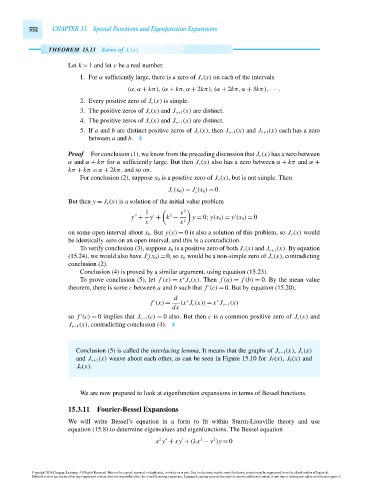Page 572 - Advanced_Engineering_Mathematics o'neil
P. 572
552 CHAPTER 15 Special Functions and Eigenfunction Expansions
THEOREM 15.13 Zeros of J ν (x)
Let k > 1 and let ν be a real number.
1. For α sufficiently large, there is a zero of J ν (x) on each of the intervals
(α,α + kπ),(α + kπ,α + 2kπ),(α + 2kπ,α + 3kπ),··· .
2. Every positive zero of J ν (x) is simple.
3. The positive zeros of J ν (x) and J ν+1 (x) are distinct.
4. The positive zeros of J ν (x) and J ν−1 (x) are distinct.
5. If a and b are distinct positive zeros of J ν (x), then J ν−1 (x) and J ν+1 (x) each has a zero
between a and b.
Proof For conclusion (1), we know from the preceding discussion that J ν (x) has a zero between
α and α + kπ for α sufficiently large. But then J ν (x) also has a zero between α + kπ and α +
kπ + kπ = α + 2kπ, and so on.
For conclusion (2), suppose x 0 is a positive zero of J ν (x), but is not simple. Then
J ν (x 0 ) = J (x 0 ) = 0.
ν
But then y = J ν (x) is a solution of the initial value problem
1
ν 2
2
y + y + k − y = 0; y(x 0 ) = y (x 0 ) = 0
x x 2
on some open interval about x 0 .But y(x) = 0 is also a solution of this problem, so J ν (x) would
be identically zero on an open interval, and this is a contradiction.
To verify conclusion (3), suppose x 0 is a positive zero of both J ν (x) and J ν+1 (x). By equation
(15.24), we would also have J (x 0 )=0, so x 0 would be a non-simple zero of J ν (x), contradicting
ν
conclusion (2).
Conclusion (4) is proved by a similar argument, using equation (15.23).
ν
To prove conclusion (5), let f (x) = x J ν (x). Then f (a) = f (b) = 0. By the mean value
theorem, there is some c between a and b such that f (c) = 0. But by equation (15.20),
d
ν ν
f (x) = (x J ν (x)) = x J ν−1 (x)
dx
so f (c) = 0 implies that J ν−1 (c) = 0 also. But then c is a common positive zero of J ν (x) and
J ν−1 (x), contradicting conclusion (4).
Conclusion (5) is called the interlacing lemma. It means that the graphs of J ν−1 (x), J ν (x)
and J ν+1 (x) weave about each other, as can be seen in Figure 15.10 for J 7 (x), J 8 (x) and
J 9 (x).
We are now prepared to look at eigenfunction expansions in terms of Bessel functions.
15.3.11 Fourier-Bessel Expansions
We will write Bessel’s equation in a form to fit within Sturm-Liouville theory and use
equation (15.8) to determine eigenvalues and eigenfunctions. The Bessel equation
2
2
2
x y + xy + (λx − ν )y = 0
Copyright 2010 Cengage Learning. All Rights Reserved. May not be copied, scanned, or duplicated, in whole or in part. Due to electronic rights, some third party content may be suppressed from the eBook and/or eChapter(s).
Editorial review has deemed that any suppressed content does not materially affect the overall learning experience. Cengage Learning reserves the right to remove additional content at any time if subsequent rights restrictions require it.
October 14, 2010 15:20 THM/NEIL Page-552 27410_15_ch15_p505-562

